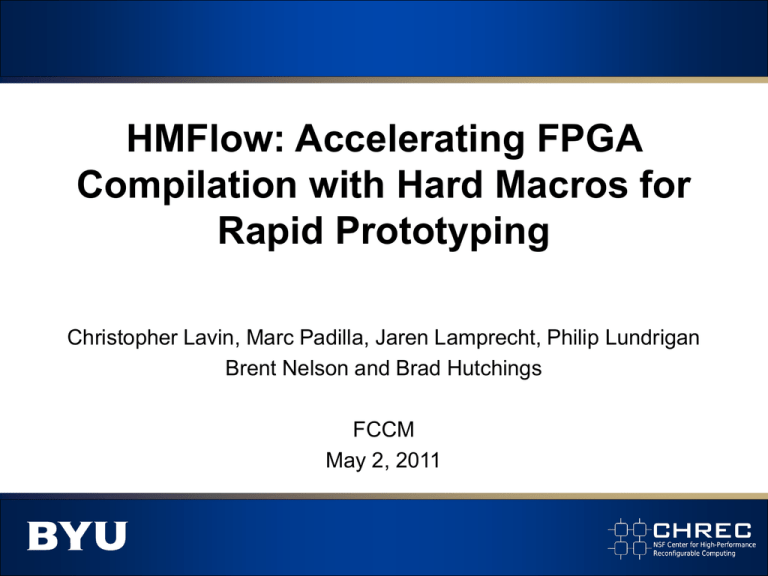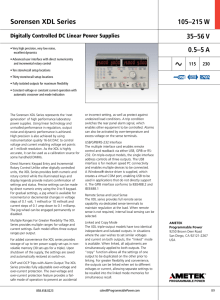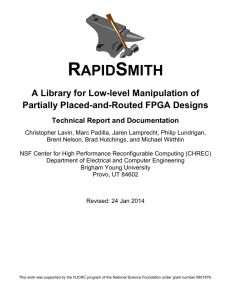hard macros - RapidSmith
advertisement

HMFlow: Accelerating FPGA Compilation with Hard Macros for Rapid Prototyping Christopher Lavin, Marc Padilla, Jaren Lamprecht, Philip Lundrigan Brent Nelson and Brad Hutchings FCCM May 2, 2011 Design Cycle Debug Compile 2 Edit The Problem FPGA Compilation Times Severely Limit Turns Per Day Reduced Productivity 3 Higher Development Costs Question Without regard for circuit quality… how fast can we make FPGA compilation? 4 Approach • Let’s emulate software compilation – Pre-compiled libraries • In hardware, these are called “hard macros” – Rapidly link, or assemble hard macros to create designs • Goals – Design to implementation in seconds – Find out: How fast can designs using hard macros be compiled for an FPGA? 5 What is a Hard Macro? • A pre-placed and prerouted module • Can be placed multiple places on the FPGA fabric • Hard-macro based design – Skips • Synthesis (XST) • technology mapping (NGDBuild) • Packing (MAP) – Design assembled from hard macros into final implementation 15 20-bit Multiplier Hard Macros 6 How To Create a Hard Macro? • Use Xilinx tools to create the macro’s circuitry • Custom area constraints generated on-the-fly • Provide sufficient area for cells (LUTs, DSPs, BRAMs) • Placed and routed NCD extracted for hard macro creation • NCD translated into XDL, converted to Hard Macro • Hard macro ports are added • Illegal primitives removed (TIEOFFs, IOBs, etc) • GND and VCC nets removed Regular Design 7 Hard Macro Design RapidSmith: Create Your Own CAD Tools • Makes writing CAD tools easier – Uses XDL as input/output format – Targets real Xilinx FPGAs • Over 200 APIs for manipulating XDL netlists • Java-based and open source – Available at: http://rapidsmith.sourceforge.net 8 Approach: HMFlow Design Parser & Mapper .mdl INPUT DESIGNS Generic HMG XDL Hard Macro Placer XDL Router XILINX PAR EQUIVALENT HM Cache HARD MACRO SOURCES 9 Design Stitcher HMFlow .xdl COMPLETELY PLACED & ROUTED XDL Built on RapidSmith What is System Generator? • A Xilinx hardware library blockset for the Simulink environment in MATLAB HMFlow supports over 75% of the System Generator block set 10 How Do You Run HMFlow? 11 One Design, Two Flows HMFlow Placed & Routed Design (XDL) XDL 2 NCD Placed & Routed Design (NCD) Placed & Routed Design (NCD) 12 How does HMFlow work? Hard Mux Macro Add Generator Addressable Shift Register Add Addressable Shift Register Mux Hard Macro Cache Hard Macro Cache 13 XDL Design Stitching the Design Design Stitcher Mux • Inserts IOBs and Clk circuitry • Examines original design and creates network connections • Design is then ready for placement and routing 14 Add Addressable Shift Register XDL Design Placement • Xilinx PAR does not handle hard macrobased designs well – Developed fast heuristic for placement • • • • Everything is only placed once, rapid results Hard macros with BRAMs/DSPs are placed first Next, largest to smallest hard macros are placed Placement attempts to place each block next to its most highly connected neighbor – Example: places 757 blocks in 219ms – Developed interactive hand placer / visualizer tool 15 Hard Macro Debug Placer 757 blocks placed in 219 ms 16 Routing • PathFinder is just too slow for our goals • (Remember: compilation speed at all costs) • Maze Router – First come first served routing resource • Very fast router – Uses ‘congestion avoidance’ instead of negotiation • Analyzes design previous to routing • Critical resources reserved to avoid conflicts • Depends on chip not being fully utilized 17 V4 Slice Counts in Benchmark Designs LX200 25000 20000 SX55 15000 10000 5000 0 18 SX35 Xilinx vs. HMFlow Runtimes 30.0 Xilinx Flow HMFlow Runtime (minutes) 25.0 20.0 15.0 10.0 5.0 0.0 19 19 10-12X Speedup Runtime Distribution of HMFlow 20 Runtime Distribution of HMFlow + XDL2NCD 21 Maximum Clock Rate of Designs 2-4X Slowdown 22 22 Conclusion • RapidSmith – Java, open source XDL CAD tool framework – Required foundation for HMFlow • HMFlow provides hard macro-based design – 10-12X speedup over fastest Xilinx flow – Scalable to very large designs – Clock rate 2-4X decrease • Still 10,000’s times faster than simulation • XDL2NCD conversion time: outstanding issue • Come see RapidSmith/HMFlow @ Demo Night 23 Related and Future Work • Related Work: Hard Macros / XDL – Next talk: Automatic HDL-based generation of homogeneous hard macros for FPGAs – USC-ISI’s Torc: Tools for Open Reconfigurable Computing • Open source project with similar goals to RapidSmith • Our Future Work – Continue support of RapidSmith – HMFlow: Larger hard macros • Maintain rapid compilation AND high clock rates • LabVIEW FPGA designs 24 Backup Slides 25 Placement Object Reduction by Using Hard Macros 30000 Hard Macro Instances 25000 Primitive Instances 20000 15000 10000 5000 0 26 10-20X Object Reduction Supported Blocks in HMFlow Over 75% of blocks supported in most commonly used System Generator packages 27 Benchmark Runtimes Design Name pd_control Simulink BlockGen Stitcher Placer Parser 0.09 0.74 0.19 0.02 0.22 XDL Export 0.06 Router 1.31 HMFlow Xilinx Total Runtime 2.8 4.1 65.6 HMFlow XDL2NCD polyphaseFilter 0.09 0.75 0.22 0.02 1.41 0.11 2.59 4.0 6.6 60.3 aliasingDDC 0.11 0.77 0.22 0.02 1.45 0.13 2.69 7.4 10.1 62.2 dualDivider 0.31 0.89 0.20 0.05 2.41 0.22 4.08 6.3 10.3 96.6 computeMetric 0.28 0.89 0.64 0.05 6.36 0.61 8.83 17.1 25.9 160.8 fft1024 0.24 0.94 0.30 0.05 4.95 0.38 6.84 10.3 17.2 119.3 filtersAndFFT 0.33 0.98 0.80 0.19 12.3 0.75 15.4 20.3 35.6 254.0 frequencyEstimator 0.44 1.50 0.58 0.22 18.1 1.17 22.0 107.3 129.3 373.5 dualFilter 0.47 1.31 1.20 0.44 34.7 1.66 39.8 140.4 180.1 469.0 trellisDecoder 0.66 1.72 1.42 0.55 54.0 2.50 60.9 115.1 176.0 824.6 filterFFTCM 0.52 1.94 1.64 0.98 69.9 3.05 78.1 541.2 619.3 1021 multibandCorrelator 0.83 1.80 1.84 1.86 73.3 5.78 85.4 506.7 592.1 786.2 signalEstimator 0.84 2.33 2.16 1.53 107.5 15.4 129.8 869.2 999.0 1509 28 All times are recorded in seconds Benchmark Attributes Design Name Slices Hard Primitive Hard Macro BRAMs DSP48s Macro Instances Instances Defs Nets Xilinx Clk HMFlow Speed Clk Speed HMFlow Speedup Time2NCD Speedup pd_control 150 1 0 200 21 12 368 147 129 50.00x 15.85x polyphaseFilter 680 8 4 777 79 30 1638 275 108 23.24x 9.19x aliasingDDC 806 1 3 876 78 25 1628 191 107 23.14x 6.17x dualDivider 1832 0 6 1951 542 39 4004 141 79 23.69x 9.34x computeMetric 2551 56 40 2799 332 64 7447 143 57 18.21x 6.20x fft1024 2553 8 12 2656 313 48 5889 215 74 17.43x 6.94x filtersAndFFT 5203 25 31 5325 588 92 11590 191 74 16.54x 7.13x frequencyEstimator 6988 31 72 7152 757 249 16919 167 60 16.97x 2.89x dualFilter 11173 33 26 11283 901 93 25961 183 46 11.80x 2.60x trellisDecoder 16973 61 53 17269 1328 196 42195 82 35 13.55x 4.69x filterFFTCM 18883 81 12 19126 920 149 49037 148 37 13.08x 1.65x multibandCorrelator 19732 52 23 19901 1472 90 47993 140 34 9.21x 1.33x signalEstimator 23841 126 47 24091 1448 390 60727 104 34 11.62x 1.51x 29 Benchmark Resource Usage as a Percentage of a Virtex4 LX200 80.0% 70.0% % Slices % BRAMs % DSPs 60.0% 50.0% 40.0% 30.0% 20.0% 10.0% 0.0% 30









